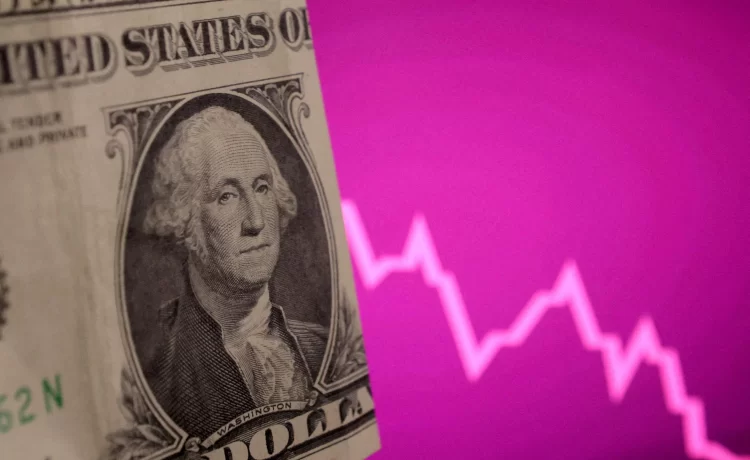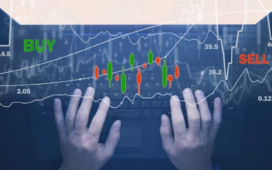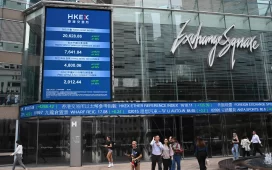[NEW YORK] The US dollar got a fresh jolt to start the week as speculation around potential trade deals sparked an extraordinary spike in Taiwan’s currency and reverberated across global foreign exchange markets.
Already under pressure as US President Donald Trump’s economic agenda dents attitudes around American assets, the greenback weakened further on Monday (May 5) against most major currencies. A Bloomberg gauge of the US dollar wrapped up the session in New York about 0.2 per cent lower after paring earlier declines.
Taiwan’s dollar led gains among the 16 major peers tracked by Bloomberg, earlier jumping the most in more than three decades on an intraday basis. The yen rallied some 0.9 per cent, leading the advance among the Group-of-10, while the euro pushed above the US$1.13 mark. China’s markets were closed for a public holiday.
Trump’s aggressive trade talk has rattled macro markets since he took office in January, undermining the US dollar’s traditional haven role in times of stress and leading investors to allocate away from US assets.
In recent days, investor focus has been on the scope and nature of any trade and tariff deals that the Trump administration will negotiate with key partners – and whether that will involve a coordinated effort among global policymakers to further weaken the greenback.
“We are all feeling a little shell-shocked in this part of the world,” Arindam Sandilya, a Singapore-based global FX strategist at JPMorgan Chase, said on a podcast describing the recent moves in Asian currencies. “The large and synchronised nature of currency appreciation is fuelling talk of some sort of currency accord among the region’s central banks.”
BT in your inbox

Start and end each day with the latest news stories and analyses delivered straight to your inbox.
While selling has moderated in May, the Bloomberg Dollar Spot Index is still down nearly 7 per cent this year, the most year-to-date since its inception 20 years ago. Traders in the speculative derivatives market, meanwhile, are the most bearish on the US dollar since September, according to the latest data from the Commodity Futures Trading Commission.
The surge in the Taiwan dollar since Friday – driven at least in part on unconfirmed speculation that any possible trade deal with the US could involve a recalibration in exchange rates – typifies the dilemma now faced by global policymakers as investors pile out of American assets amid trade policy uncertainty.
The rally in Taiwan’s currency has the potential to spill over to the rest of the developing world, said Brad Bechtel, global head of FX at Jefferies. “Or it portends some sort of currency agreement between the US and China or the US and the region that will result in all Asian currencies strengthening,” he said.
In California on Monday, US Treasury Secretary Scott Bessent countered the idea that investors are selling American assets in response to the Trump administration’s economic policies, calling the US the “premier destination” for global capital. He also spoke on trade.
“Getting better terms of trade is not always a straight line, not always a pleasant process, but I think at the end the trading relationships will be stronger, our security and values ties will still be there,” Bessent said in a conversation at the Milken Institute Global Conference.
Central banks and financial officials are responding to the sharp appreciation in local currencies.
In Taiwan, the governor of the central bank said at an emergency briefing on Monday that market commentary had triggered “excessive” buying of the Taiwan dollar by exporters and foreign investors. The nation’s markets regulator, meanwhile, met with life insurers holding US dollar-based bonds that are particularly exposed to the rally in the domestic currency.
“I would be cautious about leaning in too much into this appreciation as central banks in Taiwan, Malaysia and especially Hong Kong have significant means to buy US dollars if they need to,” said Leah Traub, a portfolio manager and head of the currency team at Lord Abbett & Co.
Evercore strategists including Krishna Guha and Marco Casiraghi noted on Monday that domestic data may dominate the tone for US assets in the days ahead, but added that currency market gyrations could seep into the market for Treasuries, which have continued to see relatively resilient foreign demand at recent auctions.
“We are seeing aftershocks from the US market turmoil and historic correlation breaks of the past month combine with fears of forced FX appreciation in Taiwan, with the potential for regional spillovers and possible spill-back into the US Treasury market,” the Evercore team wrote.
The Treasury’s so-called quarterly refunding auctions kicked off on Monday with a US$58 billion sale of three-year notes. The sale went smoothly, though indirect bidders – the category that includes foreign central banks bidding through the Federal Reserve – accounted for a smaller share of the buyers than at recent auctions. BLOOMBERG





